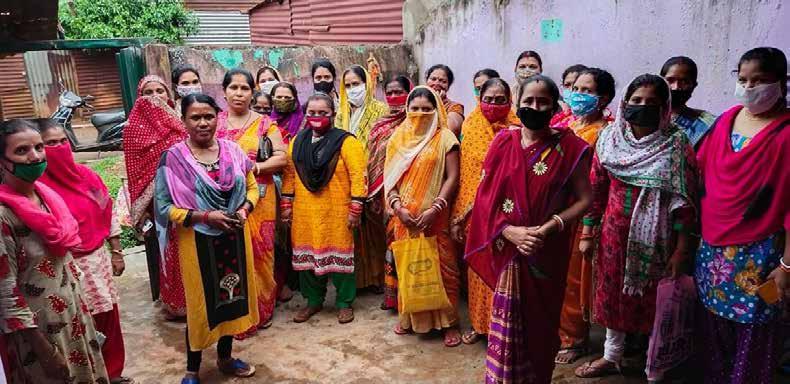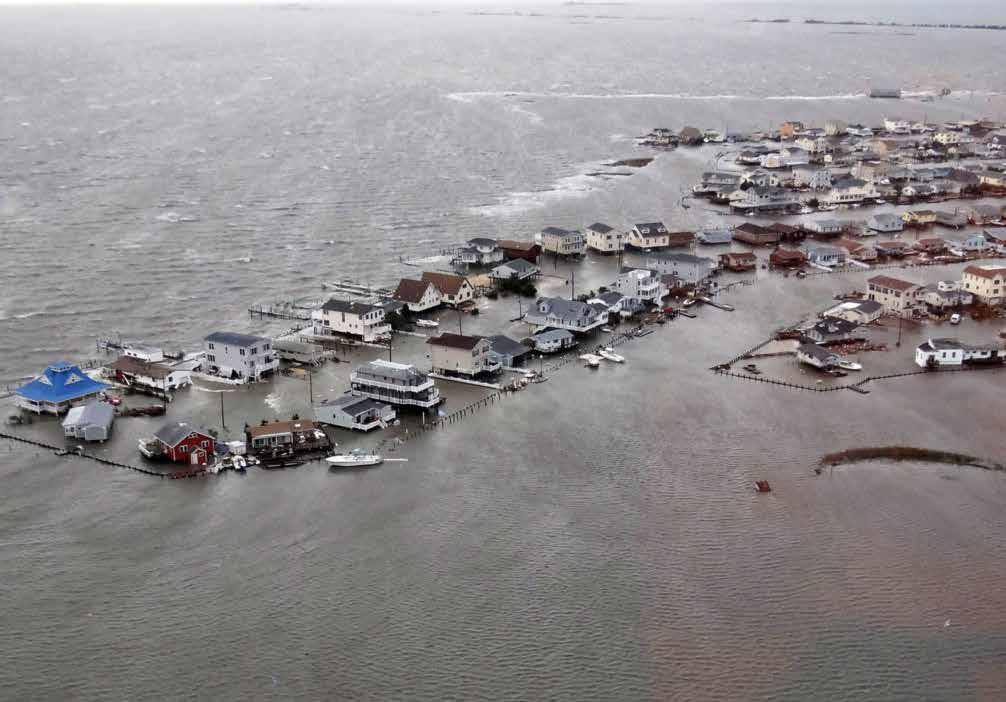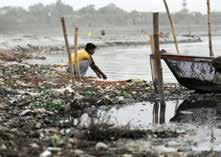
13 minute read
Empowering Women by Building Skills and Entrepreneurship
by Urban Update
Team girl power projecT
In 2019, approximately 20.7 per cent women were part of the labor force in India, in comparison to the figure being 30 per cent in 1990. The data questions the impact of the increase in literacy rate among women and their position in India. A report by the Initiative for What Works to Advance Women and Girls in the Economy on ‘Impact of COVID-19 on Working Women’ stated that inadequate mobility, safety and lack of childcare options, sexual harassment inside and outside the workplace, and a fear of being stigmatized by the community are few of the many reasons that restrict women from seeking work or pushes them to drop out of paid work. Gender plays an increasingly important role in the economic growth process, both in terms of capacity building for success and the nature of the influence of certain development plans and initiatives. In the case of micro-enterprise approaches, gender becomes especially crucial to consider, as women’s typical home-centered duties can make it far simpler for them to participate in such programs than in more traditional and medium enterprises. To counter this, the Girl Power Project, implemented by AIILSG in Jharkhand and funded by the European Union, is striving to strengthen the ability of the Indian civil society and its organizations to perform their role as independent agents of change, implanting actions that bring transformative change into the lives of women and girls. The project aims to provide women and girls with skill training and entrepreneurial support centers. Jharkhand Mahila Social Entrepreneurship Market Connect (JMSEMC) has been introduced under the project to act as a single point of contact for women and CSOs to connect them with prospective buyers in the marketplace.
Advertisement
Jharkhand is one of the backward states in India and a high level of illiteracy is witnessed, especially among women and girls, in this region. Due to this they are unable to create opportunities for themselves to chart their path towards growth and development. The following project will involve partners from within the state with innovative models and best practices to build capacities and knowledge of CSOs by engaging them with social enterprises focusing on women and girls. It will also provide skills and competencies for strengthening Self Help Groups (SHGs) and creating social enterprises for empowering women and girls. Rural markets in India have been growing much faster than the urban sector, resulting in overall social development and a balanced economy. The rural market has more potential than the urban market for consumer’s durables and services. Also, a majority of the rural population depends on agriculture, which contributes to nearly 50 per cent of the total national income. Starting your own enterprise comes with its own advantages and disadvantages. Women establishing and running their own enterprise come with added responsibilities and obstacles. During

the Baseline Survey, it was visible that there were a lot of obstacles that existing women entrepreneurs had to face on a daily basis in operating their enterprises. Women encounter significant challenges in marketing of goods and services. Lack of awareness of new products in the urban market, as well as technical skills in business administration, are major obstructions. Not only this, the remote location from the market also results in increased transportation costs. The Girl Power Project is focusing on Building self-esteem and capacity through counselling, life skills training, and mentoring support through the entire journey of self-development and growth. This includes support in making a decision, capacity building, and work opportunities, as well as overcoming barriers. It focuses on market-led enterprisebuilding, which is identifying gaps in already functioning value chains so that one knows where the maximum margins can be made to benefit the informally employed poor, create quality entrepreneurs for growing the business, laying emphasis to serve a variety of market segments and women with varying levels of capacities and social constraints. The integration aims to support women and girls to move forward confidently in new market situations. The integration allowed for linking women’s roles in the enterprise, their needs, and therefore their rights, and hence builds perspective; it is less threatening for the ecosystem than directly addressing violence against women; it is novel to have mainstreamed domestic violence issues into core business-oriented training and hence has strategic value in many contexts. Several reports after the pandemic highlight how the novel coronavirus has aggravated the gender challenge in India given the societal roles of ‘breadwinner men’ and ‘caregiver women.’ An already existing gender gap in terms of access to digital equipment and lack of knowledge on its operation and usage led to a worsened situation for many women during the lockdowns. Availability of agency and the removal of constraints faced by women and girls is essential to ensure sustainable and equitable development of a community, and in turn, a nation. Owing to several policies and campaigns, the literacy rate among women has gradually increased in rural India. However, literacy directly does not translate into a relevant skillset required for employment and there still exist major historical, social, and cultural hindrances for women and girls, especially in rural areas. In the developing world, India has some of the worst gender statistics. The contribution of women in India to its GDP is only 17 per cent which is one of the lowest in the world. The lack of decently paid and safe work, as well as the existence of a labor surplus economy, has kept women confined to unpaid care jobs, particularly in rural agricultural areas. The female labor force participation rate is one of the lowest in the world. Among those women who do work, most are in unpaid or irregular work, and continue to face tremendous barriers to success. Their creative ability has often gone unnoticed or underutilized. Focusing on women’s skills development and economic empowerment is one of the most urgent means to drive progress on poverty eradication, gender equality, and social and economic growth. When women and girls gain economic empowerment, the effects are spread across communities. Despite this, they still struggle to take their rightful place.
Mumbai, Kochi, Chennai among cities on the brink of being submerged
NEW DELHI: The Intergovernmental Panel on Climate Change (IPCC) released a report issuing direct warnings for India. The country is already going through an unpredictable upheaval in weather patterns and environmental factors, and the report said that the most dangerous risk factor for India is rising sea level that is threatening to submerge 12 coastal cities in India by the end of this century. In fact, the report established that this could lead to several coastal regions across the world being submersed.
The climate change report by IPCC warned that cities, including Mumbai, Chennai, Kochi, and Vishakhapatnam, could be nearly three feet underwater by the century’s end. The analysis was released by NASA, which used the IPCC report to assess changes occurring in sea levels across the world. The space agency identified 12 Indian cities that are likely to experience the brunt of climate change and rising sea levels if the situation is not contained in time.
IPCC has been providing assessments of Earth’s climate on a global scale every five to seven years since 1998. Their assessment focuses on changes in temperatures and ice cover, greenhouse gas emissions, and sea levels across the planet. Their projections on sea level changes are based on data gathered by satellites, on ground instruments, analysis, and computer simulations.
The report described that sea levels around Asia have been rising at a rate faster than the global average. Extreme changes in sea levels, which were previously seen once in 100 years, could happen once every six to nine years by 2050. It added that coastal areas will continue to witness sea-level rise throughout the 21st century, which will contribute to more frequent and severe coastal flooding in low lying areas. Additionally, coastal erosion with extreme sea-level events, which earlier occurred once in 100 years, could happen every day by the end of this century.
According to the IPCC analysis, climate change is bringing multiple different changes in different regions, which is expected to increase further without warning. These include changes to wet and dryness, to winds, snow and ice, coastal areas, and oceans. It noted that estimates made between 2016 and 2018 highlight global mean sea level rising at a rate of around 3.7 millimeters per year. Glaciers in the Hindu Kush Himalayan (HKH) region are expected to continue shrinking and the snow cover will retreat to higher altitudes.
Krishna Achuta Rao, one of the authors of the report, said that the snow cover has reduced since the early 21st century in the HKH region, and the glaciers have thinned, retreated, and lost mass since the 1970s. The report traced how sea levels rise and continuous melting of glaciers in the Himalayas will affect over a billion people in the Indian subcontinent, who are directly and indirectly dependent on these resources. Following is a chart of projected submersion of the Indian cities mentioned in the report.
A landmark report released by the United Nations on the state of climate science had shown that the world’s continued reliance on fossil fuels is warming planet Earth at a rate unprecedented in the past 2000
3
2.7
2.5
2
1.87 1.96
1.9 2.06
1.87 2.32
1.93
1.77 1.87 1.9
1.5
1
0.5 0.49
0
Kandla, Gujarat Okha, Gujarat Bhaunagar, Gujarat Mumbai, Maharashtra Mormugaon, Goa Mangalore, Karnataka Cochin, Kerala Paradip, Odisha Khidirpur, West Bengal
Extent of water submergence (Feet) Vishakhapatnam, Andhra Pradesh Chennai, Tamil Nadu Tuticorin, Tamil Nadu

years. Its effects are already visible as record droughts, wildfires, and floods devastate communities, and global warming continues to increase around the world. The average global surface temperature is reported to have risen by about 1.1 degrees Celsius between 1850–1900, a level not seen since 1,25,000 years. The IPCC report similarly predicted that global warming will certainly result in temperature increase in every part of the world, causing heat-waves. For India, it said that these heat-waves would be ‘extreme heat-waves’ due to how much hotter they will be in comparison to heat-waves seen in the past.
A report released by the Indian Institute of Technology-Indore on the glacial hydrology of rivers in the Himalayan Karakoram region has said that glaciers and snowmelt are important components of the Himalayan Karakoram rivers. They have greater importance for the Indus than the Ganga and Brahmaputra basins. The report had projected that the total river runoff, glacier melt, and seasonality of flow will increase until the 2050s, and then decrease.
The IPCC report laid out how large uncertainties hang in post 2050 sea level rise, and that planning and decision making practice are needed along with introduction of coordination within and between governance levels and policy domains. The responses on the issue of sea level rise (SLR), however, raise equity concerns about marginalising those most vulnerable. Therefore, they could potentially spark or compound social conflict. The report added that choosing and implementing responses to the threat is more difficult due to lack of resources, vexing tradeoffs between safety conservation and economic development, multiple ways of framing the ‘SLR problem’, power relations, and various coastal stakeholders having conflicting interests in the future development of heavily used coastal zones.
IPCC stated that using a locally appropriate combination of decision analysis, land use planning, public participation, and conflict resolution approaches can help to address the governance challenges faced in responding to sea level rise. Effective responses will depend on taking a longterm perspective when making shortterm decisions, improved coordination of SLR responses across scales, sectors and policy domains, prioritising consideration of social vulnerability and equity to promote fair and just climate resilience and sustainable development, and public awareness and understanding about SLR risks and responses. IPCC has made initial projections at the current rate only. However, if the trends continue by the end of the century, these coastal cities will go under as much as three feet of water.
Robust SWM to be implemented across J&K
Dr Arun Kumar Mehta, Chief Secretary, Jammu and Kashmir, chaired the 8th meeting of the State Level Apex Committee SLAC on Swachh Bharat Mission-Urban (SBM-U) to review the functioning of solid waste management across the union territory of Jammu and Kashmir. It was informed that under SBM, initiatives are being undertaken to implement scientific solid waste management with the aim of bringing about behavioural change and capacity-building measures. 100 per cent door-todoor collection of solid waste is being done in 984 wards with 100 per cent source segregation in 178 wards.
Andhra Pradesh to provide housing for middle-class families
The Government of Andhra Pradesh announced that they will be initiating the process of offering housing plots for middle-class families in urban areas. They will be developing a layout that is expected to promote planned and integrated development of the city. The state government has decided to do so to address the aspirations of the middle-income groups for better infrastructure and quality housing facilities. The state government will also be including basic amenities like roads, water supply, drains, and electricity in the planned layout. Families could avail the plots at a price fixed by the government for the middle-income groups. https://www.constructionworld.
Ganges water contains high level of microplastics: Study
NEW DELHI: Toxics Link, a Delhibased NGO, released a study on the high quantity of microplastic found in River Ganga. They concluded that the river, covering over 2500 km and then flowing into the Bay of Bengal, contains highly polluting microplastics. With an average length of less than 5mm, microplastics are a type of plastic debris. Since they are small in size, marine habitants ingest the debris, which is then carried further along in the food chain. The study highlighted how microplastics have affected over 660 marine species and that if consumed by humans, they can cause several health problems. The researchers also found other kinds of plastics in the samples taken from Ganga, which were taken from Haridwar, Varanasi and Kanpur. The plastic pollution was highest in Varanasi. The study highlighted that untreated sewage, industrial waste, and religious offering that are immersed in the river add to the pollutants in it. Priti Mahesh, Chief Coordinator, Toxics Link, said in an official statement that humans should reflect upon solid and liquid waste management as they are being flown into our river systems. Eventually, Ganga flows into the Bay of Bengal and then the ocean, which greatly impacts marine life.
Efforts to manage the growing pollutant levels have been going on for over 40 years now. National Mission for Clean Ganga (2011), Namami Gange (2015), Ganga Action Plan (1985) and IIT Consortium (2011) for water diversion and effective treatment have been some of the programs launched by the government to clean River Ganga. However, according to the study, these programs have not been able to yield substantial results.

Jharkhand’s immunization drive picks pace as vaccine supply arrives
RANCHI: Over 1.5 lakh people in Jharkhand received their COVID-19 vaccination dose on July 24, the highest count in a day for the month of July, reported the National Health Mission (NHM). The progress in the immunization campaign was a consequent effect after fresh supplies from the Govt of India were sent over to the state.
According to data released by the NHM, Jharkhand administered at least 1,11,529 first doses and 40,398-second doses to the beneficiaries. As of July 24, over 91,000 residents below the age of 45 years received the first jab and 1375 individuals belonging to the aforementioned age group received the second vaccine dose.
The Co-Win portal showed at least 1202 operational sites in the state on July 24. Out of the total vaccine booths, 85 were operational in Ranchi and 87 were located in East Singhbhum. Earlier in the month of July, the state’s immunization drive stopped progressing due to a shortage of vaccines. Health officials said that till July 24, around seven lakh Covishield and 40,000 Covaxin doses were in stock.
As per the data released by NHM, the active caseload in Ranchi came down to 61 and East Singhbhum’s dropped to 26 on the same day. More than 11 districts did not report any fresh COVID-19 cases on the day. The state tested over 70,000 swabs of residents and only 0.04 per cent were found infected with the virus.










